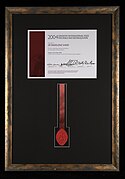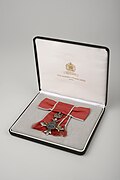
The People's Army of Vietnam, officially the Vietnam People's Army (VPA), also less formally recognized as the Vietnamese Army or the People's Army, is the military force of the Socialist Republic of Vietnam and the armed wing of the ruling Communist Party of Vietnam (CPV). The PAVN is a part of the Vietnam People's Armed Forces and includes: Ground Force, Navy, Air Force, Border Guard and Coast Guard. Vietnam does not have a separate Ground Force or Army service. All ground troops, army corps, military districts and special forces belong to the Ministry of National Defence, directly under the command of the CPV Central Military Commission, the Minister of National Defence, and the General Staff of the Vietnam People's Army. The military flag of the PAVN is the National flag of the Socialist Republic of Vietnam defaced with the motto Quyết thắng added in yellow at the top left.

Võ Nguyên Giáp was a self-taught general of the People's Army of Vietnam (PAVN), communist revolutionary and politician. Regarded as one of the greatest military strategists of the 20th century, Giáp commanded Vietnamese communist forces in various wars. He served as the military commander of the Việt Minh and later the PAVN from 1941 to 1972, as the minister of defence of the Democratic Republic of Vietnam and later Socialist Republic of Vietnam in 1946–1947 and from 1948 to 1980, and as deputy prime minister from 1955 to 1991. He was also a member of the Politburo of the Communist Party of Vietnam.

The Provisional Revolutionary Government of the Republic of South Vietnam, was formed on June 8, 1969, by North Vietnam as a purportedly independent shadow government that opposed the government of the Republic of Vietnam under President Nguyễn Văn Thiệu and then as a de facto country after the Fall of Saigon with the name Republic of South Vietnam from 30 April 1975 to 2 July 1976. Delegates of the National Liberation Front of South Vietnam, as well as several smaller groups, participated in its creation.

The Viet Cong was an armed communist organization and movement in South Vietnam, Laos and Cambodia. Formally organized as the National Liberation Front of South Vietnam, it fought under the direction of North Vietnam against the South Vietnamese and United States governments during the Vietnam War. The organization had both guerrilla and regular army units, as well as a network of cadres who organized and mobilized peasants in the territory the Viet Cong controlled. During the war, communist fighters and some anti-war activists claimed that the Viet Cong was an insurgency indigenous to the South, while the U.S. and South Vietnamese governments portrayed the group as a tool of North Vietnam. According to Trần Văn Trà, the Viet Cong's top commander, and the post-war Vietnamese government's official history, the Viet Cong followed orders from Hanoi and were practically part of the People's Army of Vietnam, or North Vietnamese army.

The Ho Chi Minh Trail, also called Annamite Range Trail was a logistical network of roads and trails that ran from North Vietnam to South Vietnam through the kingdoms of Laos and Cambodia. The system provided support, in the form of manpower and materiel, to the Viet Cong and the People's Army of Vietnam (PAVN), during the Vietnam War. Construction for the network began following the North Vietnamese invasion of Laos in July 1959.
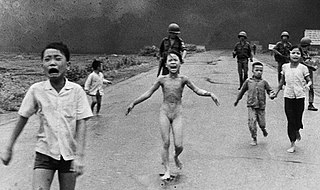
Phan Thị Kim Phúc, referred to informally as the girl in the picture and the napalm girl, is a South Vietnamese-born Canadian woman best known as the nine-year-old child depicted in the Pulitzer Prize–winning photograph, titled "The Terror of War", taken at Trảng Bàng during the Vietnam War on June 8, 1972.

The Paris Peace Accords,, officially the Agreement on Ending the War and Restoring Peace in Viet Nam, was a peace agreement signed on January 27, 1973, to establish peace in Vietnam and end the Vietnam War. The agreement was signed by the governments of the Democratic Republic of Vietnam ; the Republic of Vietnam ; the United States; and the Provisional Revolutionary Government of the Republic of South Vietnam (PRG), which represented South Vietnamese communists. US ground forces had begun to withdraw from Vietnam in 1969, and had suffered from deteriorating morale during the withdrawal. By the beginning of 1972 those that remained had very little involvement in combat. The last American infantry battalions withdrew in August 1972. Most air and naval forces, and most advisers, also were gone from South Vietnam by that time, though air and naval forces not based in South Vietnam were still playing a large role in the war. The Paris Agreement removed the remaining US forces. Direct U.S. military intervention was ended, and fighting between the three remaining powers temporarily stopped for less than a day. The agreement was not ratified by the U.S. Senate.

Army and warfare made their first appearance in Vietnamese history during the 3rd millennium BC. Throughout thousands of years, wars played a great role in shaping the identity and culture of people inhabited the land which is modern day Vietnam. Vietnam is regarded as one of the most militaristic countries in Southeast Asia, there is even a higher level belief Vietnam might be the most militaristic nation in Southeast Asia, and one of Asia and the world's most militaristic countries. The military history of the Socialist Republic of Vietnam began when Japan invaded French Indochina and soon defeated the French resistance. Since then, Vietnam has fought in many conflicts in Indochina.

Nguyễn Thị Bình, also known as Madame Bình, is a Vietnamese revolutionary leader, diplomat and politician. She became internationally known for her role as the Viet Cong (NLF)'s chief diplomat and leading its delegation to the Paris Peace Conference. The only woman among the signatories of the 1973 peace accords that ended American intervention in the Vietnam War, she later served in the government of reunified Vietnam after the Fall of Saigon and later became the country's Vice President in 1992. She is the first woman in Vietnamese history to be appointed a cabinet minister.

Madame Nguyễn Thị Định was the first female general of the Vietnam People's Army during the Vietnam War and the first female Vice President of Vietnam. Her role in the war was as National Liberation Front deputy commander, and was described as "the most important Southern woman revolutionary in the war". Furthermore, she was commander of an all-female force known as the Long-Haired Army, which engaged in espionage and combat against ARVN and US Forces.
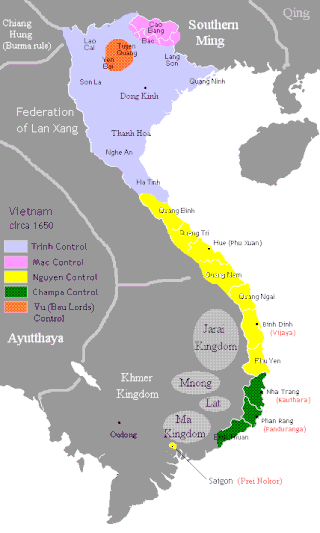
The Nguyễn lords, also known as the Nguyễn clan, were the rulers of southern Đại Việt during the Revival Lê dynasty and ancestors of Nguyễn dynasty's emperors. The territory they ruled was known contemporarily as Đàng Trong and by Europeans as Cochinchina, in opposition to the Trịnh lords ruling northern Đại Việt, known then as Đàng Ngoài. Both Nguyễn and Trịnh lords were de jure subordinates of the Lê dynasty.
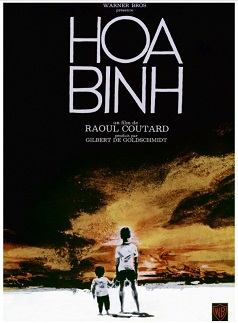
The Bamboo Incident or Hoa-Binh is a 1970 French film directed by Raoul Coutard and based on a novel La colonne de cendres by Françoise Lorrain.
Vũ Quang National Park is a national park in Vũ Quang District, Hà Tĩnh Province, North Central Coast, Vietnam. This park contains biodiversity. Saola and giant muntjac are species found in this park. Vũ Quang is a remote forested region of Vietnam, in which several new species of deer and antelope have been discovered since the 1990s. Some are so new that scientific description is still pending, although most have local names.
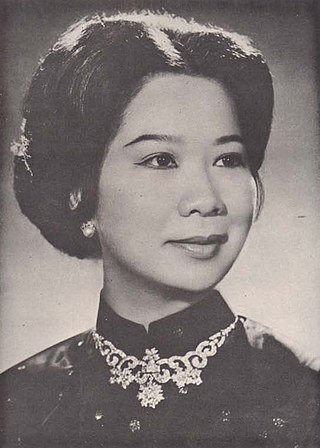
Nguyễn Thị Mai Anh, commonly known as Madame Nguyễn Văn Thiệu, served as First Lady of South Vietnam from 1967 to 1975.

This article presents an overview of the Sports in Vietnam.

North Korea–Vietnam relations is a bilateral relationship between Vietnam and North Korea. North Korea and the former country North Vietnam established formal diplomatic relations on January 31, 1950. In July 1957, North Vietnam President Ho Chi Minh visited North Korea; North Korean prime minister Kim Il Sung visited North Vietnam in November–December 1958 and November 1964. In February 1961, the two governments concluded an agreement on scientific and technical cooperation. North Vietnam merged with South Vietnam in 1976 to become the modern country of Vietnam.

Vietnam–Yugoslavia relations were historical foreign relations between Vietnam and now split-up Socialist Federal Republic of Yugoslavia. Two countries established formal bilateral relations in 1957. Relations were predominantly positive due to positive public image of Vietnam in Yugoslavia which was result of Vietnamese resistance to foreign domination and shared membership in the Non-Aligned Movement.
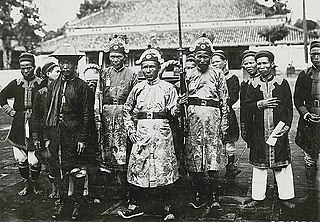
The military of the Nguyễn dynasty were the main military forces of the Nguyễn dynasty from 1802 to August 1945 when it was dismantled by the August Revolution. The Nguyễn military force was initially formed by Nguyễn Hoàng as a division of the military of the Revival Lê dynasty in 1558 starting out with 3000 soldiers. During this period it was the military forces of the domain of the Nguyễn lords and commonly fought the Trịnh lords who controlled northern Vietnam. During the Tây Sơn Rebellion it was expelled out most of the county by the Tây Sơn dynasty. After the exiled Nguyễn Phúc Ánh returned and defeated the Tây Sơn rebels he crowned himself as the Gia Long Emperor and the Nguyễn military became the national military of Vietnam.

The French conquest of Vietnam (1858–1885) was a long and limited war fought between the Second French Empire, later the French Third Republic and the Vietnamese empire of Đại Nam in the mid-late 19th century. Its end and results were victories for the French as they defeated the Vietnamese and their Chinese allies in 1885, the incorporation of Vietnam, Laos, and Cambodia, and finally established French rules over constituent territories of French Indochina over Mainland Southeast Asia in 1887.

The Vietnamese Civil War of 1787–1802, or the Tây Sơn–Nguyễn Civil War of 1787–1802, was a conflict fought between two Vietnamese factions, the Tayson in the north, and the Nguyen loyalists in the south, both intended to unify the realm. Following the Tây Sơn rebellion (1771–1789), the kingdom of Dai Viet was partitioned into three regions ruled by the Tây Sơn brothers Nguyen Nhac, Nguyen Hue and Nguyen Lu. Nguyen Phuc Anh, last of the slaughtered Nguyen lord family that had been overthrown by the Tây Sơn in the 1770s, returned to Vietnam in 1787 after spending years of exile in Siam to rally support for his fight against the Tây Sơn. Nguyen Anh and his allies effectively defeated the Tây Sơn, dismantled the Tây Sơn regime, reunited the country, and established a unified Vietnamese state in 1802.

